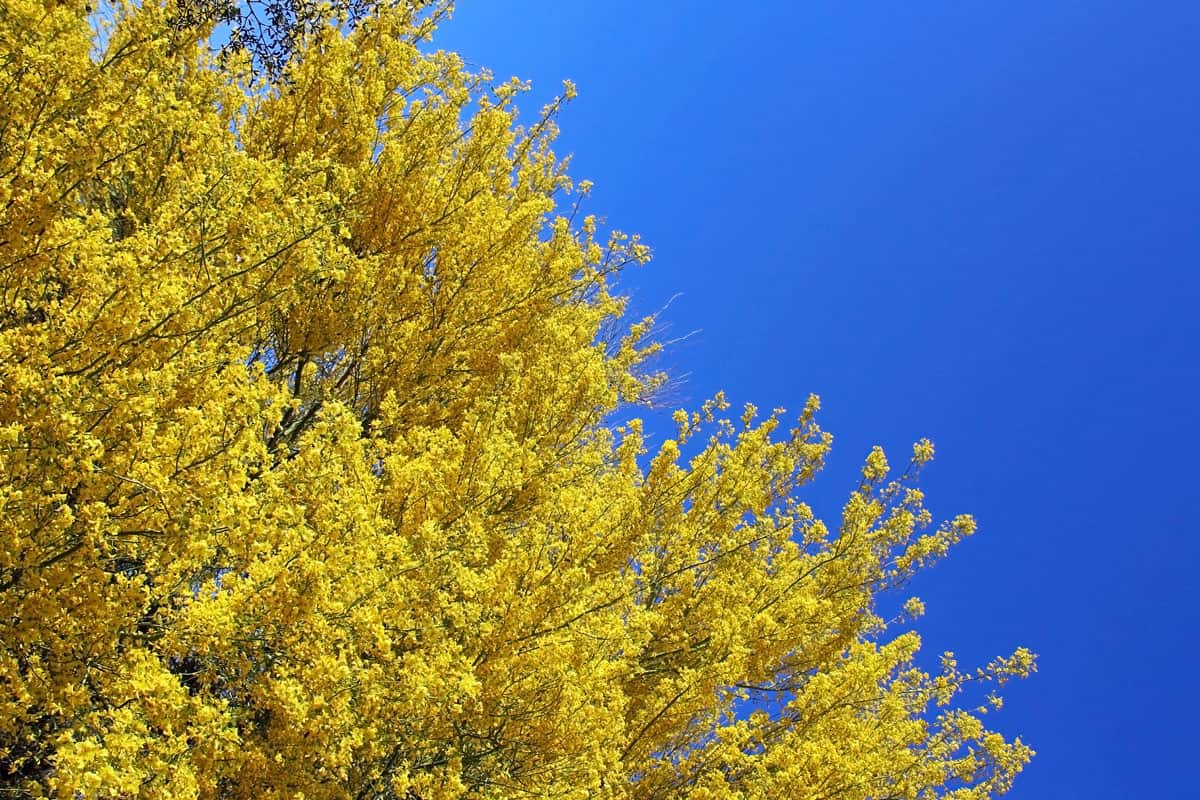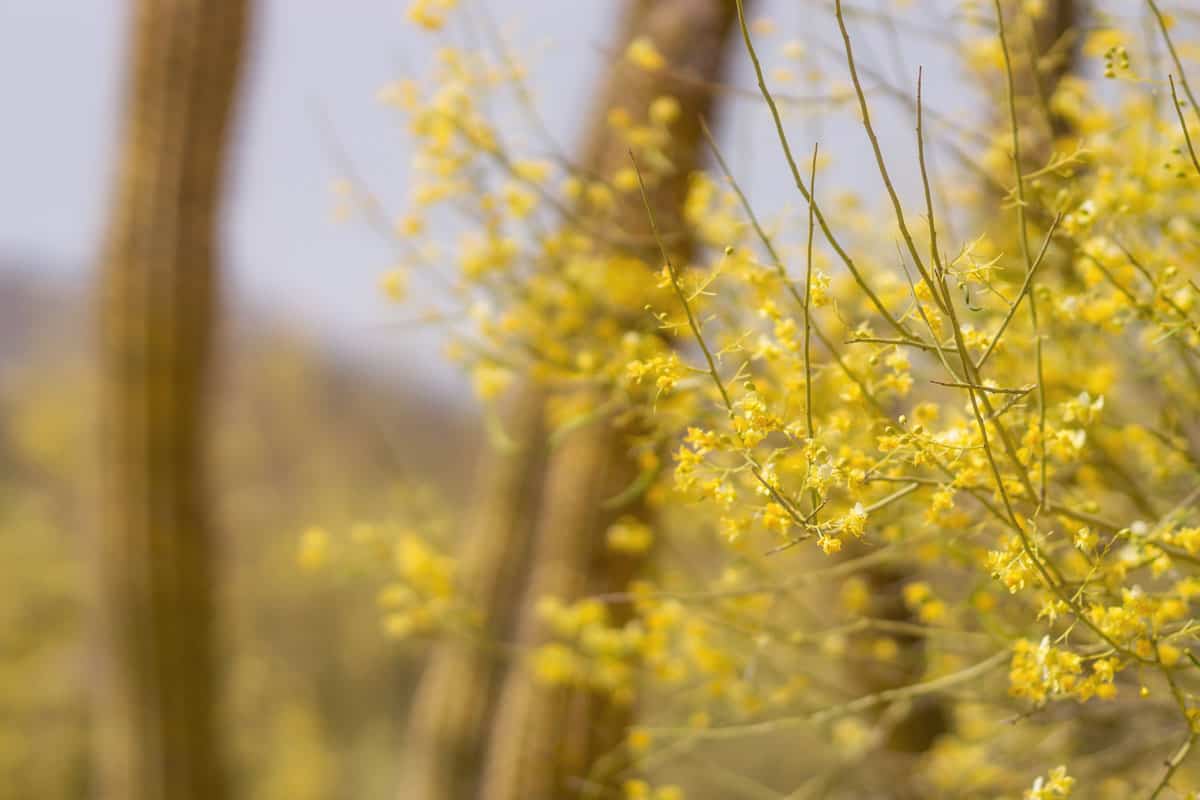It can be disheartening to discover that your palo verde tree is dying. Palo verde trees can live for over a hundred years and mature at around 30 years, so it would be a shame for your tree to die off prematurely. We have done the research to help you out with this problem!
Palo verde trees grow in arid and desert regions of the Southwest. So if your tree is dying, then it is likely due to overwatering. Poor drainage is also a likely culprit for your dying palo verde tree, as are some diseases. You can try saving your tree by doing any of the following:
- Hydrate your tree appropriately
- Prune your tree
- Get rid of any parasites or diseases on your tree
Of course, you will need to understand the cause of your tree's poor health before you can do anything to help it. In this post, we will go over some of these causes in more detail. To learn more about what you can do to save your palo verde tree from dying, read on!
![close up photo of a wonderful yellow leaves of a palo verdes tree on a hot sunny day, Why Is My Palo Verde Tree Dying? [And What To Do]](https://gardentabs.com/wp-content/uploads/2022/08/Why-Is-My-Palo-Verde-Tree-Dying-And-What-To-Do.png)
What Kills Palo Verde?
You might think it would be easier to care for a desert thriving plant, but the truth is, palo verde trees require just as much care as any other tree. If you neglect to provide for its needs, then your palo verde tree's health is on the line.

So, what kills palo verde trees?
Overwatering
If you have an otherwise healthy tree that's free of diseases and parasites, then too much water is killing your palo verde. This type of tree prefers the desert regions of the Americas and some parts of Africa, too.
An unreliable drainage system could also end up drowning your tree no matter how careful you are with watering. One thing to note, though, is that in desert washes, the trees can actually withstand the occasional flash flood. In these areas, the water is able to drain away from the tree as soon as the rainy season is over.
Soil Water Retention
Palo verde trees can grow in most soils. However, different soil types will have varying degrees of water retention.
Most clay-rich soils retain a lot of water, leading to wet tree roots. When wet, you can tell if your soil has a lot of clay when it has a clumpier, malleable, clay-like texture.
Sandy soil is preferable when growing palo verde trees, since it will not hold much water. If you cannot mix more sand into your soil, at least ensure better drainage.
Conversely, you could be underwatering your tree. You do not want your tree to dry out if you have an effective drainage system such as drip irrigation. Manage your watering schedule to prevent this from happening.
Root Binding And Rot
Palo verde roots are susceptible to rot and binding. They need space to spread and properly drain. Without much room for growth, roots will bind together and trap moisture. The abundance of unneeded moisture may even lead to rot.
Avoid over-mulching your tree. Overuse of compost and over-mulching promote bacteria growth that your palo verde is unfit to handle should there be too much. This could also lead to rot.
Insects and Pests
Common wood and root borers will also eat away at your tree, causing illness and rot. Parasites will damage the health of the tree. If insect borers damage the tree bark, then saving your palo verde tree will be more difficult.
How To Save Palo Verde Tree

Once you have figured out what is killing your palo verde tree, you can begin your journey of saving it. It will not always be easy, so take extra care and be patient as you work with what you have.
For a tree that is dying due to overwatering, reevaluate and change your watering schedule or irrigation system to one that will best suit the needs of your tree. Take steps to improve your drainage system.
Remember to prune your palo verde tree regularly! As we mentioned, palo verde trees are prone to rot. Pruning your tree can help avoid this issue. What's more, a well-pruned tree will look great in your yard!
Your tree might sometimes be unable to nourish all of its parts fully. When you notice your tree struggling to keep its green color, it may be time to remove some old leaves and branches.
By pruning off old branches, you help the tree allocate most of its nutritional resources to the younger branches. This will encourage your palo verde tree to thrive and grow for longer and faster!
If you are having trouble with pests and parasites, treat your tree accordingly. Most trees that are prone to infestations or illnesses receive treatment through horticultural oils and sprays regularly.
Insecticides and fungicides come in several varieties. So you have a choice between more chemical and more organic options. Choose the formula that is best for your tree and follow the application instructions carefully. Keep a consistent and pollinator-friendly spraying schedule.
Generally, even healthy trees would benefit from regular spraying. This way, you can avoid any problems in the future. You can also choose to consult with a horticultural specialist regarding insect and pest treatments for your Palo Verde.
What To Do When You Can't Save Your Tree
Remember, if you are at a loss for what to do or are not confident in your ability to save your tree, contact an experienced gardener or horticultural specialist who will be able to help you out. You could even learn a thing or two on how to save more trees in the future!
Click here to see Tree Insect Killer and Fertilizer on Amazon
Why Is My Palo Verde Yellow Or Brown?
Like most trees, your palo verde tree will change color during the seasons. This is normal! But pay extra care and attention to your tree if it turns yellow or brown. You want to keep your tree from eventually getting sick.
Your palo verde can lose its green hue in extreme weather. Freeze and drought, when times are exceptionally dry and the temperature is extreme, can affect your tree. A palo verde tree will not last for over a year without rain but can go dormant if the soil has no moisture.
As the leaves turn yellow and brown, they start to fall off. A healthy palo verde tree will grow leaves back in a bright green hue during the spring and may even grow yellow flowers.

One identifying factor of the palo verde is its green trunk and branches—hence, its name. The browning of the tree trunk and branches during a freeze or drought may be normal, but you should already be alert if you start noticing this.
If the bark on your tree turns brown and starts to chip away, it is high time for you to inspect it. Check for any holes or bores from possible insect infestations and treat accordingly.
How Do You Prune Palo Verde?
Palo cerde can grow up to anywhere between 20-30 feet. They also grow pretty fast, so you need to give them a good trim now and then. It is recommended to prune your palo cerde tree at least once every year, during late winter.
Your tree needs to save as much energy as it can during the winter months, making this a good time for you to cut off old and dead branches and leaves.
Maintaining your tree is pretty straightforward. You can trim your palo verde now and then, especially in the spring when it starts to grow more.
Take care to cut the branches off of the base from where they are attached to the tree. Of course, you must not forget to make sure the way you trim your tree still leaves it looking nice and shaped.
Click here to see Pruning Shears on Amazon
Can You Cut Down A Palo Verde Tree?
Different states have different regulations on tree removal. You never know if you are cutting down an important tree for your local ecosystem, which would be devastating to the environment. You also do not want to damage any property while cutting down your tree.
In the U.S., palo verde trees typically grow in the desert areas of southern California and Arizona. According to Arizona state law, landowners reserve the right to remove plants growing on their land. You must notify the Arizona Department of Agriculture 20 to 60 days prior.
As for California, only some cities require a permit just for the removal of heritage trees and oak that grow on private property. If you would like to remove your palo verde tree, especially one that has no chance of reviving, then you can do so without any paperwork.
Wrapping Things Up

Overwatering, lack of pruning, and pest infestations are some of the main things that can kill your palo verde tree. Take extra care of your tree to avoid these problems or respond to them accordingly. Remember, a healthy tree can look forward to many centuries of life!
Did you find this post helpful? Check out our other articles before you go!


